Day 68 - Melton Mowbray Pork pie
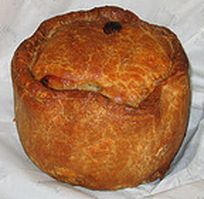
Hailing from Melton Mowbray, the pork pie has hardly changed since the middle ages. It's best when it's baked free standing... not an easy task as you can see on The Great British Bake off challenges! and injected with a savoury jelly. I LOVE them - especially with a good dollop of homemade Piccalilli and a nice cup of tea.
This history of the Melton Mowbray pork pie (taken from http://www.mmppa.co.uk/protecting.html )
Over the centuries, the Melton Mowbray area developed a very high concentration of cheese production in particular Stilton Cheese which has European Protected Status. The development of the diary industry was encouraged by the Enclosure Awards of the 1700's which incidentally created the perfect foxhunting environment. Whey, a by-product of the cheese industry, was an ideal food for pigs so pork became a common feature of the Melton diet. Originally baked in a clay pot covered with a rough pastry, the pork pie evolved to resemble a "parcel" of pastry wrapped around a pork filling. This allowed the pie to be carried whilst at work (agricultural workers, grooms and hunt servants would often carry them), and the pastry case was discarded before eating.
In the late 1700's foxhunting developed in the Melton area, Melton Mowbray becoming the centre for the three famous local hunts (Quorn, Cottesmore and Belvior) and the capital of foxhunting in England. The local pork pie was "discovered" by visiting hunters who saw their grooms and servants eating it during the 1780's. It was particularly noticed because the Melton Mowbray Pork Pie differed from other types of pies the visitors saw elsewhere.
The pie developed further, a hot water crust pastry was used as the edible casing raised by hand around a bottle or wooden dolly, hence the expression hand raising a pie. The meat of the pie when cooked was grey in colour, not pink, because the hunting season coincided with the slaughter over the autumn and winter months of local pigs, and the associated production of pork pies. The pies were baked free standing which gave their bow shaped appearance when they came out of the oven. Bonestock jelly was added to the hot pies to fill all the air spaces to preserve the meat inside the pie longer and to ensure the pie did not crumble when carried by huntsmen riding over ditches. The fresh meat, grey when cooked, seasoned with salt and pepper, crunchy pastry, succulent jelly and the distinctive bow-shape of the Melton Mowbray Pork Pie distinguished it from all other pork pies.
This history of the Melton Mowbray pork pie (taken from http://www.mmppa.co.uk/protecting.html )
Over the centuries, the Melton Mowbray area developed a very high concentration of cheese production in particular Stilton Cheese which has European Protected Status. The development of the diary industry was encouraged by the Enclosure Awards of the 1700's which incidentally created the perfect foxhunting environment. Whey, a by-product of the cheese industry, was an ideal food for pigs so pork became a common feature of the Melton diet. Originally baked in a clay pot covered with a rough pastry, the pork pie evolved to resemble a "parcel" of pastry wrapped around a pork filling. This allowed the pie to be carried whilst at work (agricultural workers, grooms and hunt servants would often carry them), and the pastry case was discarded before eating.
In the late 1700's foxhunting developed in the Melton area, Melton Mowbray becoming the centre for the three famous local hunts (Quorn, Cottesmore and Belvior) and the capital of foxhunting in England. The local pork pie was "discovered" by visiting hunters who saw their grooms and servants eating it during the 1780's. It was particularly noticed because the Melton Mowbray Pork Pie differed from other types of pies the visitors saw elsewhere.
The pie developed further, a hot water crust pastry was used as the edible casing raised by hand around a bottle or wooden dolly, hence the expression hand raising a pie. The meat of the pie when cooked was grey in colour, not pink, because the hunting season coincided with the slaughter over the autumn and winter months of local pigs, and the associated production of pork pies. The pies were baked free standing which gave their bow shaped appearance when they came out of the oven. Bonestock jelly was added to the hot pies to fill all the air spaces to preserve the meat inside the pie longer and to ensure the pie did not crumble when carried by huntsmen riding over ditches. The fresh meat, grey when cooked, seasoned with salt and pepper, crunchy pastry, succulent jelly and the distinctive bow-shape of the Melton Mowbray Pork Pie distinguished it from all other pork pies.
Day 65 - St Pirans Day & pasties
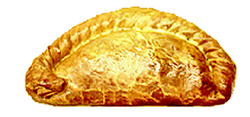
Sticking with the Cornish theme this week, it's St Pirans Day! It's the national day of Cornwall - taking place on 5th March every year, and is named after one of their patron saints, Sain Piran, who is also the patron saint of tin miners. It's a day that's celebrated with food and drink, and what better way for me to show support today, than to eat a Cornish Pasty?!
The Cornish Pasty is said to have been originally created by Cornish wives for their husbands to take down the mines for their lunch. The folds in the pastry were a way for them to hold the pasty and instead of eating the pastry, they would eat the contents, meaning that any chemicals or toxins that they had on their hands would not contaminate their food. It is also said that for some, the pastry would enable the contents of the pasty to stay warm until lunch time, and often they would have one half of the pasty contain a savoury/meat filling, and the other, their dessert. Why we haven't got a Pasty outlet serving this half and half version in the UK, I don't know!
Devon vs Cornwall
My Grandparents lived in Newton Abbot, Devon for many years throughout my childhood, and I was always told that the difference between a Cornish pasty and a Devon one, is all to do with the crimping. The Cornish is crimped down the side, and the Devon is crimped at the top. Either way I'm not fussed, just put one in my belly!
The Cornish Pasty is said to have been originally created by Cornish wives for their husbands to take down the mines for their lunch. The folds in the pastry were a way for them to hold the pasty and instead of eating the pastry, they would eat the contents, meaning that any chemicals or toxins that they had on their hands would not contaminate their food. It is also said that for some, the pastry would enable the contents of the pasty to stay warm until lunch time, and often they would have one half of the pasty contain a savoury/meat filling, and the other, their dessert. Why we haven't got a Pasty outlet serving this half and half version in the UK, I don't know!
Devon vs Cornwall
My Grandparents lived in Newton Abbot, Devon for many years throughout my childhood, and I was always told that the difference between a Cornish pasty and a Devon one, is all to do with the crimping. The Cornish is crimped down the side, and the Devon is crimped at the top. Either way I'm not fussed, just put one in my belly!
Day 64 - Cornish Yarg
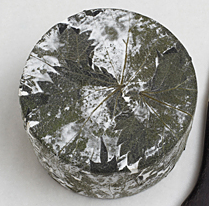
This is my favourite cheese of the moment. It won 'Best English Cheese' in 2012, and is a semi-hard cows milk cheese that's wrapped in nettles to give a slightly mushroomy aftertaste.
A lot of love and care goes in to the making of this cheese at Lynher Dairies in West Cornwall. The owners, Ben and Catherine Mead live and farm from just a few fields away from the dairy, ensuring that only the best cows milk goes in to the cheese, along with the nettles being foraged from the local area.
Available from Waitrose and any good cheese shop, I can literally go to the fridge and cut chunks off of this and eat without crackers or anything else.
A lot of love and care goes in to the making of this cheese at Lynher Dairies in West Cornwall. The owners, Ben and Catherine Mead live and farm from just a few fields away from the dairy, ensuring that only the best cows milk goes in to the cheese, along with the nettles being foraged from the local area.
Available from Waitrose and any good cheese shop, I can literally go to the fridge and cut chunks off of this and eat without crackers or anything else.
Day 59 - Orkney Herring, keep it going!
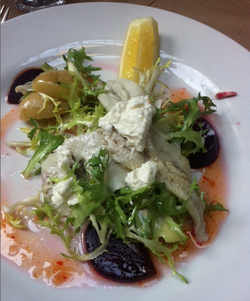
Oh my, what an absolute treat I had today - not only did I get to lunch at my favourite restaurant in Soho (Aurora's on Lexington Street), but they had Orkney Herring on the menu and it was absolutely to die for. So sweet, and meaty and served with a creamed horseradish dressing. You can't get better.
When I got back to my desk, I did a bit of research in to the production of Orkney herring and found out that the company is currently struggling to keep going. After 25 years of fishing for and producing this amazing product, they desperately need investment to help keep them going. So, any of you rich millionaires who might be out there, get your hand in your wallet please :)
When I got back to my desk, I did a bit of research in to the production of Orkney herring and found out that the company is currently struggling to keep going. After 25 years of fishing for and producing this amazing product, they desperately need investment to help keep them going. So, any of you rich millionaires who might be out there, get your hand in your wallet please :)
Day 57 - Boiled egg & soldiers
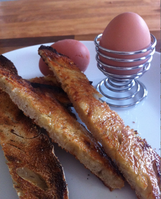
OK, OK... I know this isn't just a British dish. But for me, there's nothing more homely than a googey boiled egg with crunchy buttery toasted soldiers. Today I made my own sour dough to have with it and it was deeeelicious.
Boiled egg and soldiers - the ultimate fast food.
Boiled egg and soldiers - the ultimate fast food.
Day 55 - Dorset Crab
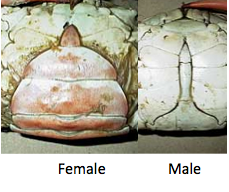
We were fortunate enough to do a review of 'The Vine' restaurant in Sevenoaks this evening. I opted for the starter of Dorset crab with a sesame prawn toast. It was absolutely delicious - but then I don't think I've even eaten a Dorset crab that hasn't been. It's such a shame that crab in this country is so bloody expensive and hard to get hold of. Even if you actually live in Dorset (I have family there) it can be hard to buy. The problem being that the Chinese also know how good our crab is, and so we end up shipping the majority of our supplies over there because we get a better price for it... absolutely outrageous!
The difference between a male (cock) and female crab
You can tell the difference between a male and female crab by looking at the shaping underneath. Simply turn them over and you'll see a long thin shape for a male and the wider more rounded for a female. Males tend to have more meat, although the meat from the female is often sweeter. Always go for a lively crab rather than one that's not moving when touched, and remember that just because the claws look big it doesn't mean they hold a lot of meat - lift it up and feel the weight of it before choosing.
The difference between a male (cock) and female crab
You can tell the difference between a male and female crab by looking at the shaping underneath. Simply turn them over and you'll see a long thin shape for a male and the wider more rounded for a female. Males tend to have more meat, although the meat from the female is often sweeter. Always go for a lively crab rather than one that's not moving when touched, and remember that just because the claws look big it doesn't mean they hold a lot of meat - lift it up and feel the weight of it before choosing.
Day 53 - Sausage rolls
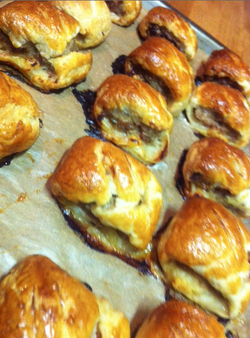
Mmmmmm.... sausage rolllllllls! Just one of my guilty pleasures, and so quintessentially British - particularly when added to a buffet table. I was going to add these under the 'make' section but they're just so easy to do that I didn't see the point in typing out a recipe - buy your puff pastry, add plenty of chopped fresh sage to your sausage meat, and a nice coating of egg to the top of your pastry before cooking - and away you go *off she goes to shove another one in her gob*
The history of the sausage roll
It's not totally clear who first came up with the idea of wrapping food in pastry. It is said to have been the Greeks or the Romans, but most agree that it was around the 18th century when it first became popular.
Whilst the french invented puffed or flaky pastry, it was a British man who thought it would be fun to wrap a sausage in it. Rumour has it that the results could hardly be called 'gourmet' but war hit and us Brits were hungry - and so the sausage roll became a part of our history.
The history of the sausage roll
It's not totally clear who first came up with the idea of wrapping food in pastry. It is said to have been the Greeks or the Romans, but most agree that it was around the 18th century when it first became popular.
Whilst the french invented puffed or flaky pastry, it was a British man who thought it would be fun to wrap a sausage in it. Rumour has it that the results could hardly be called 'gourmet' but war hit and us Brits were hungry - and so the sausage roll became a part of our history.
Day 49 - Rice Pudding
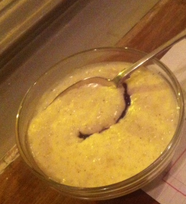
So many countries have their version of rice pudding, and our British version supposedly dates back to the Tudor period when it was called 'Whitepot' Made by either boiling the rice, or baking it in the oven, but always with plenty of milk. cream and sugar added to it. I like mine with a dollop of strawberry jam - but hubby likes a dash of cinnamon. In the North of England, it's tradition to make it with butter instead of cream, and a pinch of salt is added - served in slices once it's cooled and thickened and eaten like a cake. I've not tried this version, but think I should do the Nation a favour and give it a go :)
A little 'rice pudding' poem from Alan Alexander Milne 1882-1956
What is the matter with Mary Jane?
She's crying with all her might and main,
And she won't eat her dinner - rice pudding again -
What is the matter with Mary Jane?
What is the matter with Mary Jane?
I've promised her dolls and a daisy-chain,
And a book about animals - all in vain -
What is the matter with Mary Jane?
What is the matter with Mary Jane?
She's perfectly well, and she hasn't a pain;
But, look at her, now she's beginning again! -
What is the matter with Mary Jane?
What is the matter with Mary Jane?
I've promised her sweets and a ride in the train,
And I've begged her to stop for a bit and explain -
What is the matter with Mary Jane?
What is the matter with Mary Jane?
She's perfectly well and she hasn't a pain,
And it's lovely rice pudding for dinner again!
What is the matter with Mary Jane?
What is the matter with Mary Jane?
She's crying with all her might and main,
And she won't eat her dinner - rice pudding again -
What is the matter with Mary Jane?
What is the matter with Mary Jane?
I've promised her dolls and a daisy-chain,
And a book about animals - all in vain -
What is the matter with Mary Jane?
What is the matter with Mary Jane?
She's perfectly well, and she hasn't a pain;
But, look at her, now she's beginning again! -
What is the matter with Mary Jane?
What is the matter with Mary Jane?
I've promised her sweets and a ride in the train,
And I've begged her to stop for a bit and explain -
What is the matter with Mary Jane?
What is the matter with Mary Jane?
She's perfectly well and she hasn't a pain,
And it's lovely rice pudding for dinner again!
What is the matter with Mary Jane?
Day 48 - The British Institution that is... Delia Smith!
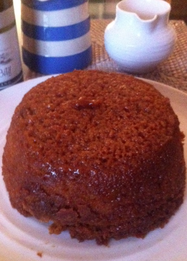
We had dinner at a friends house today, and were presented at the end of a very delicious meal with an even more delicious steamed treacle pudding. Everyone "ooooo'd" and "ahhhhh'd" as it was placed on the table with some custard and cream as I begged for the recipe... "It's a Delia" said Matt - WE LOVE DELIA!
...enough said.
...enough said.
Day 46 - Hurray for National Chip week!!
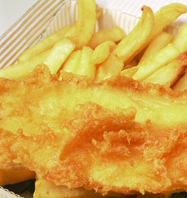
Until doing this challenge, I hadn't realised just how many 'National weeks' there were - there majority of which are inventions from marketing agencies to support brands since the success of Guinness and St Patrick's Day me thinks ;) whatever the reason, this one I likey! What better excuse to have a good old portion of British Fish n Chips than National Chip week?!
The history of Fish and Chips
Fish and Chips have been a stable for the working classes in Britain since 1860 when the first fish and chip shop opened in Cleveland Street, London by Joseph Malin. There are now said to be over eight and a half thousand fish and chip shops across the UK. Our nearest 'good' Fish n Chip shop is 'The Big Catch' in Beckenham - Get in touch and let me know where your favourite Chippy is - we'll add it to the foodie map!
The history of Fish and Chips
Fish and Chips have been a stable for the working classes in Britain since 1860 when the first fish and chip shop opened in Cleveland Street, London by Joseph Malin. There are now said to be over eight and a half thousand fish and chip shops across the UK. Our nearest 'good' Fish n Chip shop is 'The Big Catch' in Beckenham - Get in touch and let me know where your favourite Chippy is - we'll add it to the foodie map!
Day 45 - Love Hearts

Love Hearts
Today's Valentines Day and what better British symbol of love, than a pack of Love Hearts?! I've found out some interesting facts about these tasty treats that are made at the Matlow Swizzles factory. The factory, situated in Derbyshire began making Love Hearts in 1954 as a gift to be put in to a Christmas cracker - with the words "I LOVE YOU". They became so popular that they decided to make them in larger packs and sell them, with a variety of different messages. The amount of Love Hearts that are now being produced each year are enough to stretch 1.5 times around the world!
I'm looking forward to seeing the special packs currently being produced in honour of the Queens Diamond Jubilee.
I'm looking forward to seeing the special packs currently being produced in honour of the Queens Diamond Jubilee.
Day 42 - Black pudding
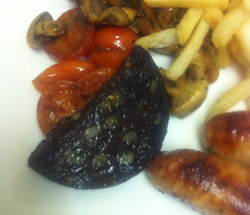
A lot of people become squeamish when it comes to eating black pudding. I suppose I've never really thought about what's actually in it, but I also think that if you're going to eat sausages (which it kind of tastes like) then there's not much difference in eating the blood of the pig if you're going to be eating everything else that gets mushed in to a sausage! It's delicious served with scallops - but the best way to eat it, is as part of a full breakfast or mixed grill... which is how I had it today... and yes, it was with extra chips - may as well go the whole 'hog'.
The history of Black Pudding
Black pudding, blood pudding or blood sausage (as it can also be known as) is made in the UK by mixing pigs blood with onions, pork fat and oatmeal. It's been in existence for as long as animals have been being slaughtered, and tends to be eaten more in the north of England than anywhere else.
The history of Black Pudding
Black pudding, blood pudding or blood sausage (as it can also be known as) is made in the UK by mixing pigs blood with onions, pork fat and oatmeal. It's been in existence for as long as animals have been being slaughtered, and tends to be eaten more in the north of England than anywhere else.
Day 37 - The Pig, a perfect place for a Great British Challenge!
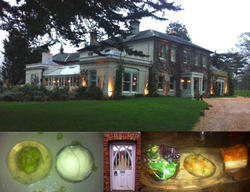
We had the pleasure of spending our second night in the New Forest at 'The Pig' in Brockenhurst. It describes itself as a 'restaurant with rooms' and has a unique approach to its menu. Everything is sourced within 25 miles of the hotel or reared and grown within their own grounds. The Chef works with the gardener to pull together dishes that are seasonal, exciting and totally British. I couldn't have found anywhere more perfect for my challenge! For dinner I had Belly of pork (from pigs reared by them) and it was accompanied by butternut squash grown in their 'food garden' and a homemade apple sauce. The crackling was out of this world, and the pork was full of flavour and moreishly succulent. Dessert was a gin and tonic jelly with ice cream topped off with sweet cucumber and popping candy.
I can't recommend this place highly enough - everything was perfect. Beautiful rooms with the best mini bar I've ever seen (full of sherbet dip dabs and locally handmade chocolates), relaxing rooms to chill in by roaring fires with plenty of books and games to keep you entertained, and rows of 'Hunter' wellies in every size and colour for guests to borrow. I can't even begin to tell you how amazing the breakfast was, you'll have to try it out for yourself. I didn't want to come home!!
I can't recommend this place highly enough - everything was perfect. Beautiful rooms with the best mini bar I've ever seen (full of sherbet dip dabs and locally handmade chocolates), relaxing rooms to chill in by roaring fires with plenty of books and games to keep you entertained, and rows of 'Hunter' wellies in every size and colour for guests to borrow. I can't even begin to tell you how amazing the breakfast was, you'll have to try it out for yourself. I didn't want to come home!!
Day 36 - Smoked kippers with scrambled eggs
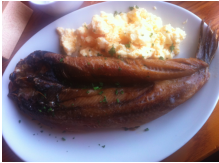
We stayed in a 'Fullers' Hotel for the night near Christchurch in the New Forest, and as their breakfast menu contained the 'New Forest Marque' for the smoked kippers, I had to give them a go. Hand smoked by the New Forest Smokery and Trout farm, and served with scrambled free range eggs supplied by 'Fluffets'.They were beautifully cooked and lightly smoked in flavour, really meaty and still allowed the taste of the fish to come through. After eating them, I realised that I hadn't actually ever eaten Kippers before - my Grandad used to eat them for breakfast all of the time, and I remember the smell lingering in my Nan's kitchen for days after. I'm going to have to give them a go when I get home. They'll certainly be making it on to my breakfast menu from now on!
Day 32 - 'Potatoes'!

My best friend took pity on my this evening and invited me over for dinner. It was supposed to be 'British' so that I could take a well deserved break from cooking at the end of the month, but unfortunately she hadn't realised that pulled pork was in fact American (or arguably Italian), and so we had to go with the good old Irish potato for a side dish. It was delicious - she'd mixed new potatoes with sweet potato (technically not British either - oh dear, but bear with us!), mashed them and then popped them in to a baking dish topped with some strong English Cheddar that was melted in the oven. It was rich, creamy, delicious and very very moreish... a dish that I'm sure Tony Blair and George Bush would have certainly been in favour of ;)
The history of the potato in Ireland The potato was not native to Ireland. It is believed that Sir Walter Raleigh brought the tuber to the island from the New World around 1570. No one could foresee that its arrival was the first ingredient in a recipe that would simmer for 275 years and produce a disaster: the deaths of thousands, the devastation of the Irish economy and the Irish Diaspora that scattered the Irish people around the globe.
At first, the potato seemed heaven-sent. It thrived in the damp Irish climate, was easy to grow and produced a high yield per acre. In the period from 1780 to 1845 it helped double the Irish population from 4 to 8 million. However, with this population explosion came an increased demand for land. The only solution was to divide the available parcels into ever smaller plots for each succeeding generation. Soon, the diminished size of these plots dictated the planting of potatoes as it was the only crop that could produce a sufficient yield of food on such limited acreage. By 1840, fully 1/3 of Ireland's population was totally dependent on the potato for its nourishment. It was a dependency that teetered on the brink of starvation and created a time bomb that needed only the slightest spark to explode.
The spark that lit the fuse was the arrival in September 1845 of the potato blight. Brought ashore from the cargo holds of ships, the blight quickly made its way to the potato fields where it spread havoc. One third of the crop was lost that year. This escalated to a loss of 3/4 of the crop in each of the two succeeding years. The small farmers suffered immediately. Starvation combined with an increased susceptibility to diseases such as typhus, dysentery and cholera devastated the population. The reaction of the British government was inadequate. By 1848, the worst was over but the devastation lingered on for a number of years. It is estimated that between 500,000 and 1.5 million people died as a result of the famine while over one million fled the country. By 1911, Ireland's population had dropped to four million.(ref: http://www.eyewitnesstohistory.com/ )
The history of the potato in Ireland The potato was not native to Ireland. It is believed that Sir Walter Raleigh brought the tuber to the island from the New World around 1570. No one could foresee that its arrival was the first ingredient in a recipe that would simmer for 275 years and produce a disaster: the deaths of thousands, the devastation of the Irish economy and the Irish Diaspora that scattered the Irish people around the globe.
At first, the potato seemed heaven-sent. It thrived in the damp Irish climate, was easy to grow and produced a high yield per acre. In the period from 1780 to 1845 it helped double the Irish population from 4 to 8 million. However, with this population explosion came an increased demand for land. The only solution was to divide the available parcels into ever smaller plots for each succeeding generation. Soon, the diminished size of these plots dictated the planting of potatoes as it was the only crop that could produce a sufficient yield of food on such limited acreage. By 1840, fully 1/3 of Ireland's population was totally dependent on the potato for its nourishment. It was a dependency that teetered on the brink of starvation and created a time bomb that needed only the slightest spark to explode.
The spark that lit the fuse was the arrival in September 1845 of the potato blight. Brought ashore from the cargo holds of ships, the blight quickly made its way to the potato fields where it spread havoc. One third of the crop was lost that year. This escalated to a loss of 3/4 of the crop in each of the two succeeding years. The small farmers suffered immediately. Starvation combined with an increased susceptibility to diseases such as typhus, dysentery and cholera devastated the population. The reaction of the British government was inadequate. By 1848, the worst was over but the devastation lingered on for a number of years. It is estimated that between 500,000 and 1.5 million people died as a result of the famine while over one million fled the country. By 1911, Ireland's population had dropped to four million.(ref: http://www.eyewitnesstohistory.com/ )
Day 31 - month down and I'm sick sick sick... bring on the soup!
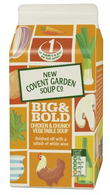
I've been hit by some kind of nasty sick bug, and so really didn't want to cook or eat anything that was too rich today... In comes hubby with a good old carton of New Covent Garden chicken and chunky veg soup. The perfect cure to an icky belly, and totally British... wish me better soon people :)
Day 29 - Strawberry jam from The Great British Pantry
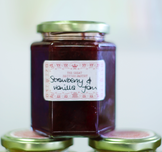
Some of you may already know that my best friend and I set up a stall in Greenwich market almost two years ago, selling our own homemade jams and chutneys. We're no longer in Greenwich, but still sell our British Fayre online and often attend various summer and Christmas fairs.
Today I popped open my homemade Strawberry & Vanilla jam - made and sealed in the summer when the strawberries were in abundance. It bought back memories of the summer, and the vanilla gives such a lovely sweetness and flavour to the strawberries - if I do say so myself! :)
Today I popped open my homemade Strawberry & Vanilla jam - made and sealed in the summer when the strawberries were in abundance. It bought back memories of the summer, and the vanilla gives such a lovely sweetness and flavour to the strawberries - if I do say so myself! :)
Day twenty six - I LOVE it!!
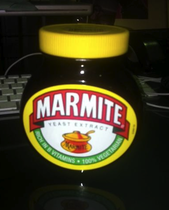
One of my favourite British cupboard items is Marmite - it's one of the very rare things that my husband and I don't agree on - he hates it, I love love love it! and so when I was given a super sized jar yesterday, I couldn't help but enjoy it on my hot buttered toast this morning. It gets me every time - I could eat it all day! Thanks Marmite :)
The history of Marmite
The Marmite Food Company (later named Marmite Ltd) was set up in Burton on Trent in 1902. With its hight Vitamin B content, it went on to support the people of Britain through two world wars, and its ad campaign 'love it or hate it' has helped aid debate in kitchens all across the country.
The history of Marmite
The Marmite Food Company (later named Marmite Ltd) was set up in Burton on Trent in 1902. With its hight Vitamin B content, it went on to support the people of Britain through two world wars, and its ad campaign 'love it or hate it' has helped aid debate in kitchens all across the country.
Day twenty five - Happy birthday Mr Burns!
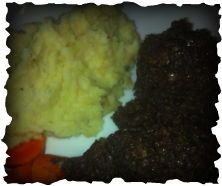
So, today is Robert Burns birthday and it's tradition in Scotland to enjoy a feat of Haggis, and to 'address' it with a poem of his. I've always loved Haggis, and have known that it's made up on lamb offal, but was never sure of exactly which bits. Well, now I know - it's liver, kidney and heart. There's something about eating an animals 'heart' that I don't quite like the idea of. It's not that I'm squeamish, and I'll eat mostly anything - I think it's more a spiritual thing. Anyway, the haggis was still delish! and I served it with a parsnip and potato mash, and some carrots - along with a quick gravy made from Bisto and a good dollop of my homemade tomato chilli jam.... with a little Whisky to wash it down :)
Day twenty four - Irish butter
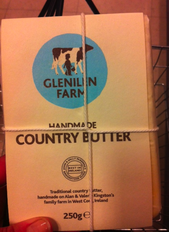
I came across this on my lunch break in Waitrose and had to get it because the packaging looked so beautiful! It's creamy, and delicious and goes sooo well with some crusty fresh bread. It also looks like Glenilin Farm in West Cork produce lots of other products, from lemon cheesecake to clotted cream, so I'll have to check some of those out too (all in the name of research of course!)
Day twenty two - Blackberry & apple crumble
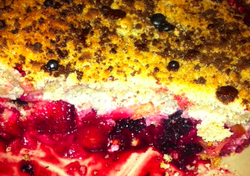
Thanks to a stash of blackberries left over in the freezer that we'd picked in the summer, and some cooking apples that we had going spare, my husband decided to cook me a nice blackberry and apple crumble for dinner. I always leave it to him to make the crumbles and bread pudding in the house, because his is definitely the best!
The history of crumble
Although we British invented the name 'Crumble' - the dish actually originated from an American 'Apple Crisp' recipe first published in 1924. It's still a favourite on British tables in the autumn though when it's most useful to use up all of the apples from the garden.
The history of crumble
Although we British invented the name 'Crumble' - the dish actually originated from an American 'Apple Crisp' recipe first published in 1924. It's still a favourite on British tables in the autumn though when it's most useful to use up all of the apples from the garden.
Day Nineteen - Burns night at the Rib Room Bar & Restaurant, London
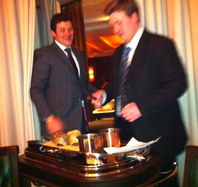
I was invited to a food bloggers event at the Rib Room Bar & Restaurant to celebrate and early Burns night. A-M-A-Z-I-N-G food, service and cocktails that should keep be going on the 'British Challenge' front for the rest of the year! Visit my food blog www.whatiatelastnight.com for the full review, but below is recipe for the welcome cocktail that they invented especially for the evening, and that's now top of my all time most favourite cocktails ever list...
Slàinte
Ingredients
5 drops of Vermouth
50 ml of Hendricks Gin
15ml of Scottish heather syrup
Method
Stir the vermouth, gin and the syrup in a mixing glass full of ice cubes
Double strain, serve up in a chilled martini glass
Slàinte
Ingredients
5 drops of Vermouth
50 ml of Hendricks Gin
15ml of Scottish heather syrup
Method
Stir the vermouth, gin and the syrup in a mixing glass full of ice cubes
Double strain, serve up in a chilled martini glass
Day Eighteen - Buffalo mozzarella
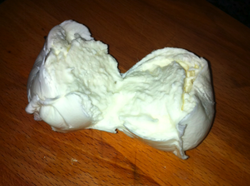
I thought I'd be deprived of one of my favourite cooking ingredients whilst carrying out the Great British Challenge, but thanks to Laverstoke Park Farm in Hampshire I can happily eat away in the knowledge that it's been produced and reared right here in the UK. The flavour is amazingly delicious, but the texture a little dryer and chewier than the Italian variety. Nonetheless, it's amazing in salads or toasted on top of some chunky white bread with chopped tomatoes and garlic. Laverstoke not only produce their own mozzarella, but also ales, lager, chicken, pork chops, sausages and even biltong! Thank you Britain for keeping up with the Jones's :)
Laverstoke products can be purchased via Ocado online, or direct from their own site. I first came across them at the Real Food Festival when they only had a few products, the quality of their food has continued to improve, and their price point is still quite competitive.
Laverstoke products can be purchased via Ocado online, or direct from their own site. I first came across them at the Real Food Festival when they only had a few products, the quality of their food has continued to improve, and their price point is still quite competitive.
Day Seventeen - Pie 'n' Mash

Ahhhh... the food of my youth :) I remember my Dad taking me to Simple Simons pie n mash shop for a Saturday treat in Lewisham when I was younger, and my cousin and I treating ourselves with our pocket money when we got older to Goddard's in Deptford. Manze's was across the road, but you were either in one shop or the other, and I was a Goddard's fan. Unfortunately the number of pie n mash shops are now in decline, but thanks to re-locating to Islington for work, I came across a Manze's today which has helped to bring back some memories and help overcome a craving. You just can't beat a double pie, mash and liquor with plenty of pepper and vinegar, and a can of coke. Infact my family loved it so much that we named our Independent film company after it www.pienmashfilms.com - check it out for some gritty, Great British Films :)
The history of pie n mash According to Goddard's - The origins of pie and mash can be traced back to the 18th century with "Eel Pie and Mash Houses" being popular places to buy a cheap and filling meal. Early pie and mash is very much different to the dishes we enjoy today, the first pies were filled with eels as these were cheap and plentiful and caught right from the Thames. Pie and mash grew up in and around London with it's roots stuck firmly in the East End of London. The River Thames was a big influence in how food traditions were formed as it provided fresh water and salt water fish in good supply. London also had a great variety of meat, vegetable and fruit brought up the Thames from all over the world.
For more info visit http://www.pieandmash.org.uk/
The history of pie n mash According to Goddard's - The origins of pie and mash can be traced back to the 18th century with "Eel Pie and Mash Houses" being popular places to buy a cheap and filling meal. Early pie and mash is very much different to the dishes we enjoy today, the first pies were filled with eels as these were cheap and plentiful and caught right from the Thames. Pie and mash grew up in and around London with it's roots stuck firmly in the East End of London. The River Thames was a big influence in how food traditions were formed as it provided fresh water and salt water fish in good supply. London also had a great variety of meat, vegetable and fruit brought up the Thames from all over the world.
For more info visit http://www.pieandmash.org.uk/
Day fourteen - Pub lunch!
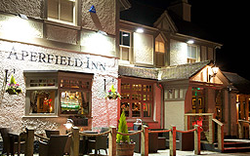
It seems that we don't have many 'British' restaurants in the UK, and so to get our fix of great pies and traditional dishes, we have to head to the local pub. There's nothing better than a brisk walk, followed by a real fire and a heart warming plate of great British food, and so that's what we decided to do today. I had calve's liver and bacon, followed by a sticky toffee pudding and custard... great British food at its best!
the history of the great British pub
A public house, or pub is fundamental to our British culture. It's where the great debates, plans and foundations of our country have been discussed, and there are currently 53,500 public houses in the UK. Sadly the number declines almost every week, making way for trendy bars or chains rather than local independent establishments, but it seems that the cosy pub is thankfully becoming popular once again, being the focal point of the community. The history of pubs can be traced back to Roman taverns from the Anglo-Saxon alehouse to the development of the modern tied house in the 19th century.
the history of the great British pub
A public house, or pub is fundamental to our British culture. It's where the great debates, plans and foundations of our country have been discussed, and there are currently 53,500 public houses in the UK. Sadly the number declines almost every week, making way for trendy bars or chains rather than local independent establishments, but it seems that the cosy pub is thankfully becoming popular once again, being the focal point of the community. The history of pubs can be traced back to Roman taverns from the Anglo-Saxon alehouse to the development of the modern tied house in the 19th century.
Day Seven - Steak & Chips
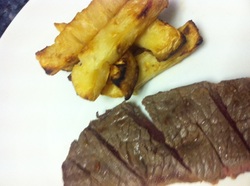
Though the origin of steak and chips is a very French concept, I'd class this as a British Eat' because the sirloin steak is very much from a British cow, and the chis that I made to go with it were made from celeriac - very in season, and again grown in the UK. Both items were bought from Polehill in Kent - a place that used to be one of my favourite places to buy seasonal, local produce. Unfortunately, a victim of its own success, it has now cranked up its prices to ridiculous proportions so that it makes it impossible to buy more than the odd luxury item, unless you're absolutely loaded and can afford to fill up your basket (£4.99 for a very smal jar of jam/£7.99 for a small tub of ice cream!). Thankfully the meat counter is still reasonable and they stock some great local meat. Whilst I was there, I also bought some game for my game pie that I'm making on Sunday.
Day Five - Jellied Eels!
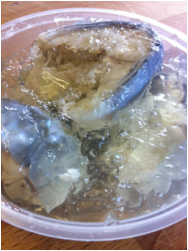
So many people turn their nose up at jellied eels, but I was brought up on food like this - I loved it when the FA Cup final was on, because my Dad would have all of his friends over and there would be bowls and bowls of delicious seafood for me to steal. The first time I tried an eel, was in Lewisham market at the fish stool. My Dad showed me how to smother the bowl of eels in plenty of white pepper and vinegar and told me to be very careful of the bone in the middle. I threw it in to my mouth, jelly and all - crunched down and then was told very quickly to spit it all out before I swallowed the bones. The second attempt was more successful, sucking the meat and silky flesh from the sides of the bone. I absolutely loved it, and now travel for miles to find myself some decent, lightly silvered eels for a weekend treat. The best I've found near to where I live, is of course Billingsgate, but you have to be up bright and early to hit the market and be prepared to buy a tub the size of a washing up bowl.
The history of Jellied Eels
Jellied eels have been a traditional English dish since the 18th century. They're most popular in the East End, where they're boiled in spiced stock, then left to cool and set, forming the delicious jelly. In pie n mash shops, you can eat them warm served with liquor (which used to me made form the head of stewed eels) and I've also eaten them in many Chinese dishes. They have a really meaty earthy flavour to them, and they used to be a cheap, nutritious and readily available food source of food for Londoners because they were so commonly found in the Thames.
The history of Jellied Eels
Jellied eels have been a traditional English dish since the 18th century. They're most popular in the East End, where they're boiled in spiced stock, then left to cool and set, forming the delicious jelly. In pie n mash shops, you can eat them warm served with liquor (which used to me made form the head of stewed eels) and I've also eaten them in many Chinese dishes. They have a really meaty earthy flavour to them, and they used to be a cheap, nutritious and readily available food source of food for Londoners because they were so commonly found in the Thames.
Day Three - Eat the Season!
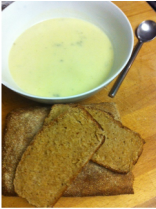
In order to eat British food at its best, and in the most cost efficient way we should look to eat seasonally. So, taking my shiny new Mark Hix 'British seasonal food' book, I turned to January and not fancying deviled kidneys or cod tongues (according to Sue Perkins in this weeks Waitrose Weekend guide - fish offal is gonna be all the rage this year!) I opted for a simple cauliflower soup. I took him up on his suggestion of adding some cheese at the end (we've got a lot of stilton left over from Christmas)
To accompany my soup, I decided to make my own whole-meal bread. I've never been great at bread making, and today was no exception.... dense on the inside and crispy on the outside... so don't worry I won't bother sharing my recipe with you here until I've perfected the art. The soup was delicious - very cheap, and I replaced double cream and whole milk for skimmed milk instead - so also healthy.
The history of the cauliflower:
Cualiflowers were introduced to the UK in the 17th Century. Full of folic acid and vitamin B6 but only 4 in 10 UK households eat cauliflower compared to its far more popular cousin the broccoli. Some sources state that the cauliflower comes from asia, where others state Cyprus (which historically was a former British colony).
What's in season for January?:
Early winter cauliflower, beetroot, brussel sprouts, celeriac, chicory, potatoes, kale, leeks, green cabbages, parsnips, turnips, jerusalem artichokes, shallots, mushrooms, forced rhubarb, apples and pears. Duck, guinea fowl, hare, partridge and venison. Brill, clams, cockles, haddock, halibut, hake, john dory, lemon sole, monkfish, mussels, oysters, plaice and turbot.
Recipe for Cauliflower & stilton soup
- Serves 4 -
Ingredients: 1 knob of butter, 1 large leek, roughly chopped, 1 medium sized onion roughly chopped, 1 whole medium sized cauliflower roughly chopped, 1000ml vegetable stock, 200ml skimmed milk, ground black pepper & sea-salt for seasoning. Crumbled stilton to taste.
Instructions:
1. Melt the knob of butter in a large saucepan on a medium heat then add the onions and leeks, cover with a lid and leave to simmer for 4 minutes until soft
2. Pour in the stock, milk, seasoning and chopped cauliflower, cover again and leave to simmer for a further 30 minutes.
3. Remove the pan from the heat and blitz the soup with a hand blender until smooth. 4. Pass the mixture through a sieve, then pop it back on the heat to warm through. Add in the stilton to taste
Serve in large bowls with deliciously chunky warm bread and butter.
To accompany my soup, I decided to make my own whole-meal bread. I've never been great at bread making, and today was no exception.... dense on the inside and crispy on the outside... so don't worry I won't bother sharing my recipe with you here until I've perfected the art. The soup was delicious - very cheap, and I replaced double cream and whole milk for skimmed milk instead - so also healthy.
The history of the cauliflower:
Cualiflowers were introduced to the UK in the 17th Century. Full of folic acid and vitamin B6 but only 4 in 10 UK households eat cauliflower compared to its far more popular cousin the broccoli. Some sources state that the cauliflower comes from asia, where others state Cyprus (which historically was a former British colony).
What's in season for January?:
Early winter cauliflower, beetroot, brussel sprouts, celeriac, chicory, potatoes, kale, leeks, green cabbages, parsnips, turnips, jerusalem artichokes, shallots, mushrooms, forced rhubarb, apples and pears. Duck, guinea fowl, hare, partridge and venison. Brill, clams, cockles, haddock, halibut, hake, john dory, lemon sole, monkfish, mussels, oysters, plaice and turbot.
Recipe for Cauliflower & stilton soup
- Serves 4 -
Ingredients: 1 knob of butter, 1 large leek, roughly chopped, 1 medium sized onion roughly chopped, 1 whole medium sized cauliflower roughly chopped, 1000ml vegetable stock, 200ml skimmed milk, ground black pepper & sea-salt for seasoning. Crumbled stilton to taste.
Instructions:
1. Melt the knob of butter in a large saucepan on a medium heat then add the onions and leeks, cover with a lid and leave to simmer for 4 minutes until soft
2. Pour in the stock, milk, seasoning and chopped cauliflower, cover again and leave to simmer for a further 30 minutes.
3. Remove the pan from the heat and blitz the soup with a hand blender until smooth. 4. Pass the mixture through a sieve, then pop it back on the heat to warm through. Add in the stilton to taste
Serve in large bowls with deliciously chunky warm bread and butter.